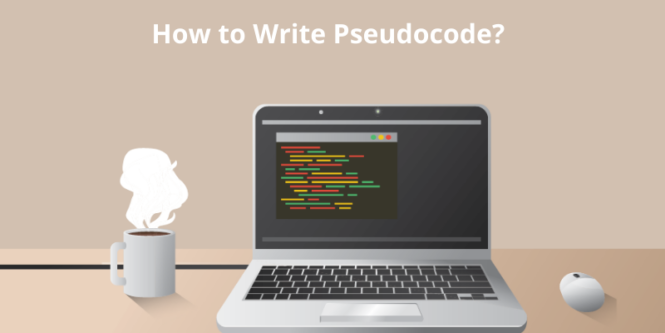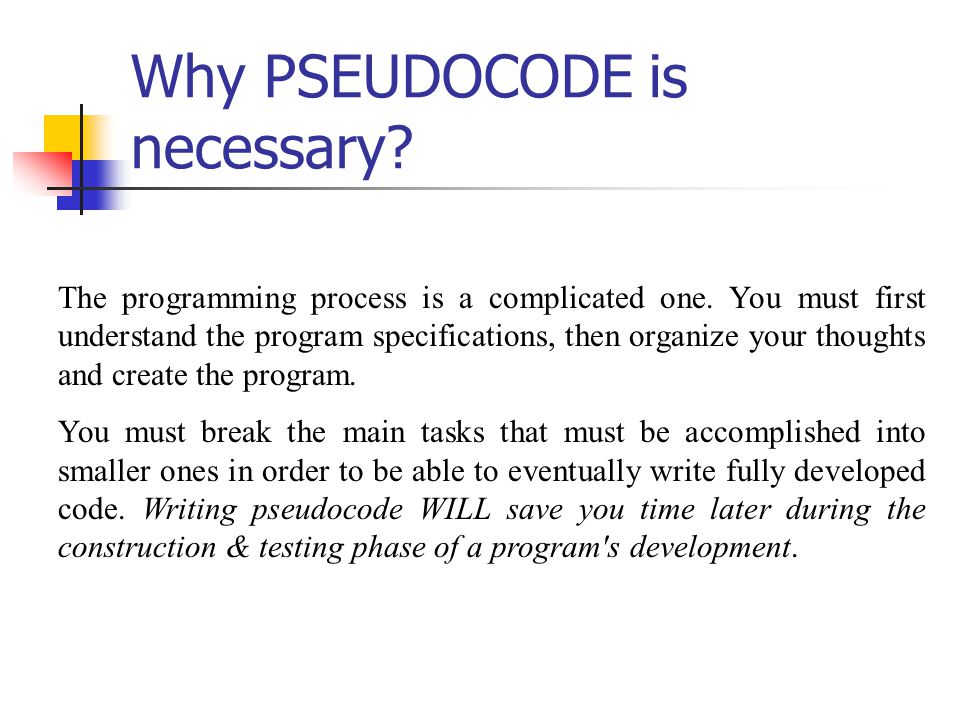
In my previous tutorial I have introduced what is Pseudocode and its Advantage and Disadvantages and few more things. If you don’t know about Pseudocode then please go and check that tutorial which is very helpful for you Click on the link to know about Pseudocode. Now in this Tutorial I will explain How to Write Pseudocode with step by step.
The pseudocode means an algorithm to be expressed without respecting certain rules in the syntax. You may quickly communicate thoughts and concepts to other programmers, even if they use entirely different languages, by studying pseudo code reading and writing. Moreover, the ability to convert between a pseudo-code and a particular programming language is typically found through the pseudo-code of Websites like Wikipedia.
There is no perfect pseudocode, however there are several notes well recognized by programmers that are usually accepted. For example, for x <— 10, the variable x should assign a new value of 10 and the variable x should not already exist beforehand. Let’s start writing Pseudocode.
Write a Pseudocode with steps:-
Step 1:- Use an editor with plain text. It might be tempting to construct a rich text document using a word processor (e.g. Microsoft Word), but pseudocodes need to be as little as possible, so that they are easily formatted.
Step 2:- Begin by outlining the process purpose. Dedicating a line or 2 to describe the purposes of your code helps to establish the rest of the text. The aim is also to explain to every individual to whom the pseudo-code is displayed the functioning of the software.
Step 3:- Only write one code per line. In your pseudocode, each sentence should include just one computer activity. If the task list is drawing correctly, in most circumstances, then each task matches one pseudo-code line. Please construct your job list, then translate it into pseudocode, then develop the pseudocode in real computer-readable code.
Step 4:- Effectively use white space and indent. The use of white spaces between “blocks” of the text will assist to isolate the various components of your pseudo code and signal that these parts are placed within a section that does not have indent.
Step 5:- If required, capitalize on essential commands. You may need to use instructions that stay in the actual code according to your pseudocode needs or to the environment in which the pseudocode is published.
Step 6:- Simple terminology is used to write. Remember, you write what the project is going to do and don’t sum up the code itself. This is especially necessary if a person who does not know coding, or as a project for a rookie programmer, has pseudo code to be a demonstration.
Step 7:- Maintain the correct sequence for your pseudocode. While it should be straightforward to edit your pseudocode, each element of your pseudo code still has to be kept to the extent that it needs execution.
Step 8:- Leave the imagination nothing. It is important to detail everything that happens throughout the process. Pseudocode declarations are close to straightforward statements in English. Pseudocode often does not use variables but rather explains how a program is running, such as account numbers, names or amount of the transaction, should behave for closely connected items.
Step 9:- Use standard structures for programming. Even when no pseudocode standard is available, the usage of existing (sequential) language structures will make it easier for other programmers to comprehend your processes. Use phrases such as “if,” “then,” “while,” “otherwise” and “loop,” just as in your favorite language of programming.
Step 10:- Arrange the portions of your pseudo code. You might wish to use brackets or other identity cards to keep it all contained, if you have huge parts of pseudocode that define additional pseudocodes in the same block.
Step 11:- You have to Double check the Readability and clarity for duplicate your pseudocode.
Creating an Example of How to make a Pseudocode Document

Step 1:- Open an editor for plain text. If you don’t want to install a new software, you may use Notepad (Windows) or TextEdit (Mac) by default.
Step 2:- Define your program. Define your program. Writing one or two-sentence lines at the head of the document will not be technically essential but will make the purpose of the program apparent from the beginning.
Step 3:- Write the sequence of opening. The first thing your program has to perform when you execute, should be the first line your first command
Step 4:- Add next line. Check out — Enter — and then construct the following line of code, between the last line and the next. The user should prompt the following dialogue line in this instance.
Step 5:- Adding the call in action. The user will be asked to welcome you in this example.
Step 6:- Display the user’s answer list. Again, the user should see the list of possible answers after pressing the entry key.
Step 7:- Request the user’s input. This is where the application requests a response from the user.
Step 8:- Creates user input “if” instructions. Since the user can pick different replies, you will want to add numerous results according to your answer.
Step 9:-Add a message of error. If the user picks an answer wrongly, an error message may be provided.
Step 10:- Add any more software components. Go over your work and add or clarify any elements so that you and anybody reading the paper understand its significance.
Your completed pseudocode should look like this:-
Why Should I Write Pseudocode?

Generally, a computer program uses a properly stated algorithm to solve a problem. But both the issue to be resolved and the recipe/algorithm to be resolved are first written in natural language (very similar to day-to-day speaking). We need a lot tighter set of computer instructions, but it may be quite laborious and hard to direct from natural language to computer – especially if you need to use several different computer languages (and we very often do).
The rewriting of this method as a collection of particular instructions is generally more preferable, but is extremely similar to computer code and not computer-specific. It appears like a computer command, but it cannot be carried out on a computer. That’s what we call pseudocode.
Email- contact@devopsschool.com

